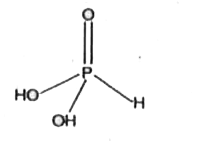(i) Ammonia is good complexing agent. Explain.
(ii) PCI exists as [PCl6]−[PCl4]+ but PBr5 exists as[PBr4]+[Br]− . Explain.
(iii) Cl5 is known but PIs is not known. Why?
(iv) Suggest a method for the laboratory preparation of DCI. Write a balanced equation for the reaction.
(v) H3PO3 is diprotic acid. Explain.
Text Solution
(i) Ammonia is a good complexing agent because of the presence of lone pair of electrons on nitrogen. This lone pair can easily be donated to electron deficient compounds forming complexes. For example, it reacts with Cu2+ ion to form a deep blue complex.
Cu2+(aq)+NH3(aq)→[Cu(NH3)4]2+complex (deep blue)
(ii) Both PCl5 and PBr5 have trigonal bipyramidal geometry. This is not a regular structure and is not very stable. Therefore, PCI5 splits up into more stable octahedral and tetrahedral structures, which are stable than trigonal bipyramidal.
PCl5⇔[PCl6]−[PCl4]+
On the other hand, PBr5 splits up into stable tetrahedral structure as :
[PBr5]⇔[PBr4]+[Br]−
This splitting is different from PCl5 because Br atoms are large and six atoms of Br cannot be easily accommodated around smaller P atom. (iii) Due to small size of Cl atom, five Cl atoms can be accommodated around P atom. But I is of large size and therefore, five I atoms cannot be accommodated around P atom. As a result, P-I bonds are weak and prefer to formPI3 rather than PI5
(iv) Hydrolysis of PCl5 with heavy water (D2O) gives DCI
PCl5+D2Oheavy water →POCl3+2DCl
(v) H3PO3 has three H atoms and therefore, it is expected to be tribasic. However, in its structure, two hydrogen atoms are joined through oxygen atoms and are ionisable. The third H atom is linked to P and is non-ionisable.

|
Topper's Solved these Questions
- P BLOCK ELEMENTSBOOK - MBD -HARYANA BOARDCHAPTER - P BLOCK ELEMENTSEXERCISE - SHORT ANSWER TYPE QUESTIONS
36 Videos
- ORGANIC COMPOUNDS CONTAINING NITROGENBOOK - MBD -HARYANA BOARDCHAPTER - ORGANIC COMPOUNDS CONTAINING NITROGENEXERCISE - Long Answer Type Question
4 Videos
- POLYMERSBOOK - MBD -HARYANA BOARDCHAPTER - POLYMERSEXERCISE - Long Answer Type Question
9 Videos
Similar Questions
Knowledge Check
Solid PCl5 exists as
ADimer P2Cl10B[PCl4]+[PCl6]2−C[PCl3][Cl2]DPCl5 as moleThe solid PCl5 exists as
APCl5 moleculesBP2Cl10C[PCl4]+[PCl6]−DnoneThe solid PCl5 exists as
APCl3BPCl+4CPCl−6DPCl+4andPCl−6
